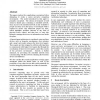Free Online Productivity Tools
i2Speak
i2Symbol
i2OCR
iTex2Img
iWeb2Print
iWeb2Shot
i2Type
iPdf2Split
iPdf2Merge
i2Bopomofo
i2Arabic
i2Style
i2Image
i2PDF
iLatex2Rtf
Sci2ools
ACSW
2003
2003
A Secure Pervasive Environment
This paper explores the complications encountered when attempting to create a secure pervasive computing environment. The model introduced in this paper is primarily conceptual. The chosen environment is built around a shared space containing a classified network. Since access to the classified network is only available to people once they are in this space, we investigate what is required to ensure only authorised people can enter, which highlights problems inherent in any kind of physical access control, and then how to carry this through to manage their access to information once inside the space. A layered agent architecture is considered, using real time devices such as biometric mechanisms, door actuators and a smart card reader acting as the lower level agents. These agents are then wrapped in software allowing them to communicate with higher level agents that through the coordination of these low level agents control the security of the pervasive environment. Security is furth...
| Added | 31 Oct 2010 |
| Updated | 31 Oct 2010 |
| Type | Conference |
| Year | 2003 |
| Where | ACSW |
| Authors | Patrick G. McLean |
Comments (0)

